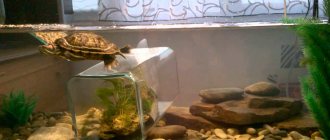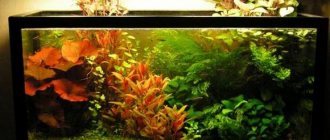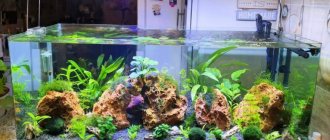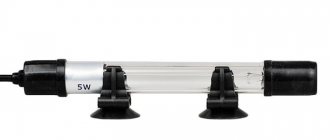When planning to set up an aquarium, many people believe that it is enough to fill it with water, sprinkle beautiful stones, plant exotic flora, add the fish you like, and you can enjoy the beauty of the underwater world.
In fact, such a frivolous approach will most likely lead to the fact that the inhabitants of the home pond will very soon get sick and die.
The health of your pets will largely depend on their living conditions and how well the devices for maintaining life in the aquarium are selected.
Water is the basis of the living environment for fish and beneficial microflora. Its preparation should be taken care of first.
Water for aquarium at home
Many novice aquarists often ask questions about what kind of water to fill, how long it should sit, and why does the water become cloudy? To save time and not have to worry about carrying out all the activities, you can purchase special aquarium water. But this option cannot be called budgetary (prices range up to $1 per liter depending on the volume), and transporting large containers causes difficulties. This article will discuss how to prepare water yourself at home.
Settling time
How long it takes to settle water for an aquarium is a very important question, since you should figure out in advance how long it will take for the liquid to completely settle and be safe for the inhabitants. On the Internet, aquarists often talk about different settling times. Basically these are the following values:
- stand for one night;
- one day;
- seven or ten days.
It is recommended to leave water for fish for one day. The optimal option for settling is one day. As you know, solid impurities settle almost immediately , and if after a day the sediment is not visible, then it will not appear.
Getting rid of gaseous impurities occurs already at the moment of filling the liquid into the container. They quickly evaporate and with vigorous stirring for several minutes.
How long the water for an aquarium should sit depends also on the container in which it was collected. The container must be voluminous and open so that the process of releasing harmful components is completed within a day. For these reasons, leaving the liquid to sit for a week or more is not advisable. If the water is extremely polluted, has a high chlorine content and a large amount of solid impurities, then the settling can be extended to two days.
As a result, it turns out that the answer to the question of newbie aquarists about how many days to settle water for an aquarium is very simple. It is enough to leave it for 24 hours, which is not that long, but necessary.
How to properly settle water and how long should water for an aquarium settle?
When filling water for the first time or partially replacing it, there is no need to rush. It is necessary to let it stand for 2-3 days so that the volatile chlorine compounds evaporate, and the water stands and finds complete biological balance. You can speed up the process by heating it to 70 degrees, or saturating it with oxygen using a compressor. But the water obtained by such methods is not yet completely ready for settlement.
After removing chlorine impurities, you can fill the aquarium. Before introducing the fish, it is better to place aquarium plants in it and only after a week can you celebrate the housewarming.
Destruction of solid impurities
Most often, tap liquid is used to fill the tank, which is pre-settled to destroy impurities. How to settle aquarium water to remove solids before changing the aquarium water:
- The liquid is poured into a transparent container, and a shower hose is used. The top of the vessel is covered with gauze.
- The vessel with water is left for two hours in a secluded place.
- After two hours, the settled liquid is carefully inspected, avoiding shaking the water. Solids are found in the form of sediments and pieces of rust.
- Having noticed solid impurities, water must be poured into another vessel and left for another two hours. After a while, the water is inspected again, and if solid impurities are still present, the procedure is repeated again until the water becomes completely transparent.
How long it will take to settle the water depends on the composition of the liquid used. For areas where contaminated water flows, it will take longer.
How to prepare the water in the aquarium for adding fish
Settling the water before adding and launching fish and shrimp is a mandatory procedure. To achieve the desired result, it is important to do the following correctly:
You can stand water only in containers suitable for drinking (food containers or ordinary glass jars are suitable). To prevent air circulation from being disrupted, do not cover them with lids. It is better to use mesh fabric (gauze).
Settled water is safe for fish if it is done by topping up or partially replacing it. When setting up your home for the first time, you can start the fish 6-7 days after the flood. This is necessary so that a biological environment has time to form in the aquarium.
Filtration
Filtration maintains a favorable aquarium environment and is used along with sedimentation. There are three types of filtering:
- biological;
- mechanical;
- chemical
Biological filtration involves purification using beneficial bacteria. With mechanical water passes through the filter material. For chemical cleaning, natural minerals of the zeolite group, ion exchange resins, and peat are used.
What is the pH of water in an aquarium and how to find out the indicators
A novice aquarist will soon have to remember his school chemistry course. Specifically, the concept of “water acidity” or pH level. It is its sudden change that can lead to illness among the inhabitants of the glass house, and even their death. The pH level shows the amount of carbon dioxide in the water. If the pH is less than 7, the aquatic environment is considered acidic; if the pH is greater than 7, it is alkaline. Where does carbon dioxide come from in an aquarium? It is released by fish and underwater plants at night. In addition, various chemical reactions constantly occur in water, which lead to changes in this indicator.
Most tropical fish prefer hard water, with a pH ranging from 4 to 7. The spawning period begins with the onset of rains, and the water becomes softer. If you want to increase the population of the aquarium, this information must be taken into account when changing the water.
To monitor the pH, test tubes and reagents for accurate measurements are commercially available. Electronic pH meters can be purchased.
Features of water treatment before launching fish
Water treatment depends on what kind of aquarium the water will be poured into. It’s one thing when it’s just starting an aquarium, another thing is regular replacement in an aquarium that already has fish or other inhabitants.
In case of startup, the water does not need to settle at all. It is enough to leave the aquarium open - do not close the lid and turn on the aeration. The very next day there will be no chlorine in the water; accelerated gas exchange due to aeration greatly contributes to the weathering of chloride compounds.
When the water is being prepared for replacement, it is worth taking care of the weathering of chlorine in advance:
- Pour tap water into an enamel or plastic container. Only one point is important here - the surface area, the larger it is, the faster the chlorine will disappear.
- Next, it would be a good idea to ask the water supply company exactly how the water is disinfected before it comes out of the tap. If using chlorine, then it is better to let it stand for two or three days, if using chloramine, a day will be more than enough.
- If necessary, warm the water slightly to the temperature in the aquarium.
Spring and bottled
Despite the fact that this water does not need to be settled, some aquarists try to defend it. Such actions do not cause any harm to the inhabitants, nor, in fact, any benefit.
Bottled water can be poured into the aquarium immediately, and spring water can be added immediately after the water temperature is equal to the temperature in the aquarium.
What does ozonation of water in an aquarium mean and how to find out the indicators
Many people face the problem of cloudy water. And the point is not that the appearance of the aquarium is spoiled. Water becomes unusable due to the rapid proliferation of bacteria. More often this happens in a densely populated aquarium with a soft and acidic environment. What should I do?
Systematic ozonation of water solves two problems: disinfection of the internal space and oxidation of most organic impurities contained in the liquid. To saturate water with ozone, there are special devices - ozonizers. You can buy them in a store or make them yourself.
It is important to remember that oversaturation of water with gas is harmful to aquarium inhabitants. It is better to perform the procedure in a separate container. If this is difficult, ozone is applied in the aquarium, but special filters are used to prevent direct contact of living creatures with gas bubbles.
Alternative Methods
For those who do not have time for such manipulations with buckets, there are several alternative methods of water treatment:
- Boiling. During boiling, water reaches its maximum level of gas exchange, and chlorine-containing gases evaporate instantly.
- Special conditioners – Tetra AquaSafe, Aquayer Antichlor, Mosura Shizem, etc.
- Use osmotic or distilled water.
Is it possible to put fish in unsettled water?
As stated earlier, chlorinated tap water without proper treatment is unsuitable for aquatic life. Chlorine can be removed in two ways:
- the first method is intensive aeration, i.e. saturating water with oxygen using an aquarium compressor;
- the second is the use of a special preparation - a conditioner, which removes not only chlorine, but also other chemicals and heavy metals dangerous to fish. In this case, you do not need to wait several days for the water to settle. The conditioner is sold at any pet store. You just need to read the instructions carefully before use.
If you are preparing an aquarium for the first time, it is advisable to use both methods.
Conclusion
As it turned out, preparing an aquarium for fish on your own is not so difficult. You just need to be patient and follow the simple recommendations given in this article.
Water for aquarium fish at home:
Why is it necessary?
Water, before entering the water supply system, passes through a filtration station.
There it is disinfected, filtered and made suitable for drinking and household needs.
It is disinfected with chlorine, which is very dangerous not only for aquarium fish, but also for all living things. If you pour chlorinated water into an aquarium, you can poison the fish, but, as a rule, the chlorine content in tap water is not too high.
A small concentration of chlorine has no effect on fish, but even a small dose can attack colonies of beneficial bacteria. And this is the most important component of the biological balance in a small underwater world; without it, water begins to:
- become cloudy
- turn green,
- everything is covered with ugly algae,
- an unpleasant odor appears.
Over the past few years, large filtration plants have begun to use chloramine instead of chlorine . This is a compound of chlorine and ammonia, which is not as toxic as chlorine itself and disappears much faster.
But during epidemics, such as with covid-2019, in large cities water is subjected to intensive disinfection with chlorine in large dosages. Therefore, standing up is more important than ever.
Reference! The main task of settling is to allow the dissolved chlorine to erode. This does not happen quickly, sometimes it may take 3-4 days, but after that, the water becomes absolutely suitable for use in the aquarium.
Basic Rules
When preparing, it is important to take into account the following components:
- solid – settle at the bottom of the container;
- gaseous - evaporate;
- liquid (the most rare) - remain in the water.
Water can only be used after a number of procedures:
- cleaning (by settling or using conditioner);
- regulating indicators in accordance with standards;
- mineralization.
The temperature must be monitored
Experienced aquarists have long protected themselves from such troubles as the need to lower or increase the degrees. To keep fish within optimal temperature limits, the following rules should be taken as a basis.
- Choose the “right” place for the aquarium: away from heating devices, air conditioners, away from direct sunlight (especially in summer) and drafts.
- The heating pad must be of high quality and have a reliable sensor.
- A thermometer is a must-have device for any aquarium. Select its location so that it is convenient to monitor the scale indicators.
- Aeration is not a fad, so the compressor should be turned on regularly. Without enough air, what kind of habitat would be comfortable?
How to lower the water temperature in an aquarium:










